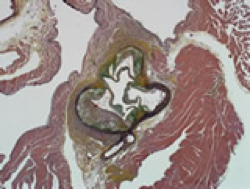Atherosclerosis is a disease that begins with the invasion and accumulation of white blood cells, or foam cells, onto artery walls. The thickening of the artery walls results in proliferation of intimal-smooth-muscle cell creating an atheromatous plaque. This build up, while usually staying asymptomatic for years or even decades, can eventually lead to thromboembolisms, coronary thrombosis, strokes, heart attacks and/or infarction.
Models of Atherosclerosis
-
Progression models
- The effects of a test article on aortic plaque formation and lipidemia may be investigated using either a progression or regression study in ApoE or other mutant mice fed a high fat diet. Mice are placed on the diet from 6-16 weeks and the test article is administered. End points include blood lipids, cholesterol, and triglycerides, as well the assessment of formation of plaque (plaque burden) in the aortic sinus. Assessment of plaque may be conducted using a Paigen type method with histomorphometry.
-
Regression models
-
Hyperlipidemia
- Hyperlidemia in high fat fed Watanabe rabbitsThe effects of a test article on blood lipidemia, liver lipidosis and plaque formation may be investigated using either a progression or regression study in Watanabe rabbits or WHHL rabbits fed a normal or a high-fat diet. Rabbits are placed on the diet and the test article is administered. End points include blood lipids, cholesterol and triglycerides, liver pathology, and assessment of formation of plaque in the aorta.
- Hyperlipidemia in high fat-fed hamsters or guinea pigsBoth hamsters and guinea pigs become lipidemic and develop atherosclerosis when fed a high fat diet. The effects of a test article on blood lipidemia, liver lipidosis and plaque formation may be investigated using either a progression or regression study in hamsters and guinea pigs fed a high fat diet. Animals are placed on the diet and test article is administered. End points include blood lipids, cholesterol and triglycerides, liver pathology, and assessment of formation of plaque in the aorta.

Look to CBI for validated models for the assessment of atherosclerosis and hyperlipidemia, including progression and regression studies. Assessment of plaque may be conducted using a Paigen type method with histomorphometry.


